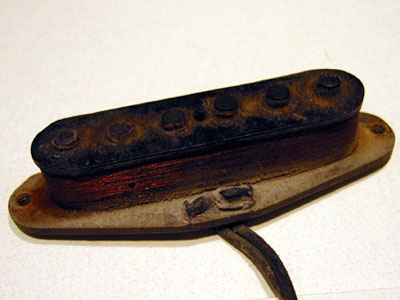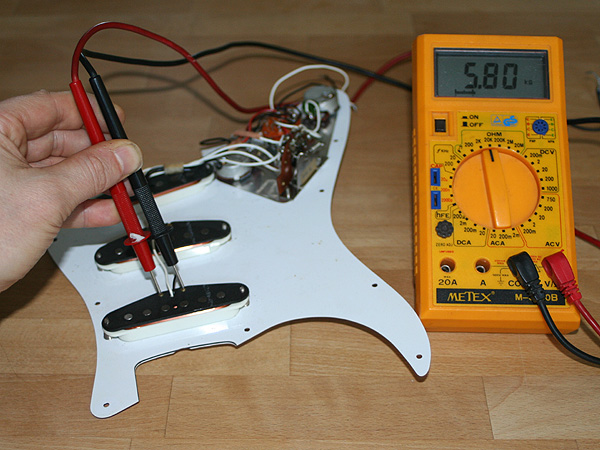A guitar pickup does not contain any moving parts, and for this reason it is generally free of mechanical wear and might work for many decades (maybe even for centuries?). Nevertheless, certain pickup models seem to be prone to die earlier than others. One example are Fender pickups from the 50ies or early 60ies. For this reason you will often see vintage Stratocasters with rewound pickups. The same is true for the Schecter F500T – a tapped pickup which consists of two individual coils.
It is mostly corrosion of the magnets that kills the pickup
The reason is simple. A pickup consists of some magnets and a coil – in case of a standard Fender-type singlecoil pickup we have individual magnetic pole pieces for each string, but some pickups also have non-magnetic metal pieces (or screws) that are connected to one bar magnet that often sits below the bobbin. The coil consist of hair-thin wire that is wound around the magnets. The wire is an extremely thin copper wire that is insulated with some film (e.g. laquer, formvar or enamel). For this reason – the wire itself is insulated – it is not necessary to insulate the magnets from the wire.
Now the problem: the magnets are made of metal – normally alnico which is an alloy of ALuminium, NIckle, and Cobalt – , and metal can corrode when exposed to humidity or other environmental factors like sweat, beer, or whatever. It is this corrosion of the magnets in the interior of the pick-up that can destroy the wire of the coil.
There are two different things that can happen: (a) the wire breaks and the pick-up will not produce any output at all anymore, or (b) only the insulation is destroyed and the coil is shortened. The pick-up will still produce some output but not as much as it normally does. It depends on the number of turns that are shortened how much output the pick-up will produce – any value from 0 – 100% is possible.

Fender reacted to the problem which killed so many pickups from the 50ies and applied a thin coat of laquer on the pole pieces before winding the coil. Alternatively some manufacturers put some tape around the pole pieces.
Measurung the resistance of the pickup
The exact diagnosis of a defective pickup is simple. All you need is to measure the resistance of the coil with a multi meter (or to be concrete an ohm meter). Make sure that the pick-up is NOT switched on at the 5-way (or whatever) pick-up switch, but switched OFF. Then measure between the two poles where the cables are soldered to the pick-up. If you don’t want to open the guitar, you can also turn up the volume and tone controls, switch on the pick-up and measure at the output jack (plug in a guitar cable and measure between the two poles of the other plug). However, this measurment is not as exact as the other method since the potis will be in parallel to the pickup and reduce the resistance you will measure)

If the wire is broken, the multimeter will read an extremely high value (indefinite), if it is shortened it will read lower than the normal resistance of the pick-up (which is about 6 kohms in case of a vintage-style Stratocaster pick-up)
If the pickup is defective, there is nothing you can do to repair it except exchange it or let it be rewound by a specialist. If the correct type of wire is used, there should be no audible sound difference after the job.
If you are looking for a replacement for the Schecter F500T pickup, you should check out our tapped pick-ups by the German pick-up specialist Harry Haeussel. Click on the image below for more info.


One thought on “Why do certain pickups like Stratocaster pick-ups from the 50ies or the Schecter F500T die so often?”
On most videos it is hard to see the switch positions, but on some you can of course, e.g. the BBC Tunnel of love version from the Alchemy bonus clips has first the middle PU alone with both coils, then in the slow part middle and neck, and later bridge&neck, all PUs full.